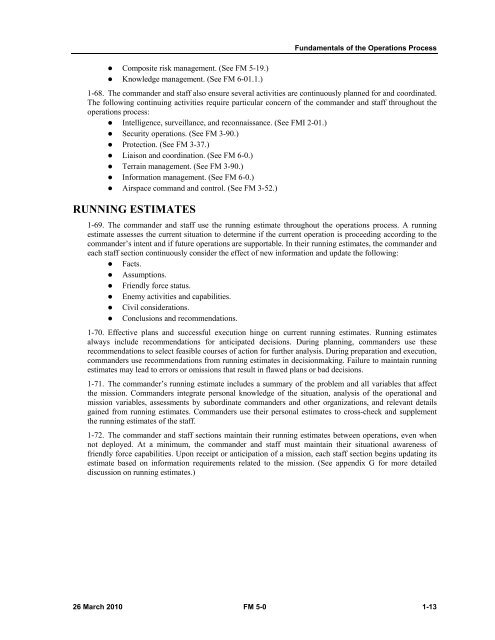FM 5-0, The Operations Process - Federation of American Scientists
FM 5-0, The Operations Process - Federation of American Scientists
FM 5-0, The Operations Process - Federation of American Scientists
You also want an ePaper? Increase the reach of your titles
YUMPU automatically turns print PDFs into web optimized ePapers that Google loves.
Fundamentals <strong>of</strong> the <strong>Operations</strong> <strong>Process</strong><br />
• Composite risk management. (See <strong>FM</strong> 5-19.)<br />
• Knowledge management. (See <strong>FM</strong> 6-01.1.)<br />
1-68. <strong>The</strong> commander and staff also ensure several activities are continuously planned for and coordinated.<br />
<strong>The</strong> following continuing activities require particular concern <strong>of</strong> the commander and staff throughout the<br />
operations process:<br />
• Intelligence, surveillance, and reconnaissance. (See <strong>FM</strong>I 2-01.)<br />
• Security operations. (See <strong>FM</strong> 3-90.)<br />
• Protection. (See <strong>FM</strong> 3-37.)<br />
• Liaison and coordination. (See <strong>FM</strong> 6-0.)<br />
• Terrain management. (See <strong>FM</strong> 3-90.)<br />
• Information management. (See <strong>FM</strong> 6-0.)<br />
• Airspace command and control. (See <strong>FM</strong> 3-52.)<br />
RUNNING ESTIMATES<br />
1-69. <strong>The</strong> commander and staff use the running estimate throughout the operations process. A running<br />
estimate assesses the current situation to determine if the current operation is proceeding according to the<br />
commander’s intent and if future operations are supportable. In their running estimates, the commander and<br />
each staff section continuously consider the effect <strong>of</strong> new information and update the following:<br />
• Facts.<br />
• Assumptions.<br />
• Friendly force status.<br />
• Enemy activities and capabilities.<br />
• Civil considerations.<br />
• Conclusions and recommendations.<br />
1-70. Effective plans and successful execution hinge on current running estimates. Running estimates<br />
always include recommendations for anticipated decisions. During planning, commanders use these<br />
recommendations to select feasible courses <strong>of</strong> action for further analysis. During preparation and execution,<br />
commanders use recommendations from running estimates in decisionmaking. Failure to maintain running<br />
estimates may lead to errors or omissions that result in flawed plans or bad decisions.<br />
1-71. <strong>The</strong> commander’s running estimate includes a summary <strong>of</strong> the problem and all variables that affect<br />
the mission. Commanders integrate personal knowledge <strong>of</strong> the situation, analysis <strong>of</strong> the operational and<br />
mission variables, assessments by subordinate commanders and other organizations, and relevant details<br />
gained from running estimates. Commanders use their personal estimates to cross-check and supplement<br />
the running estimates <strong>of</strong> the staff.<br />
1-72. <strong>The</strong> commander and staff sections maintain their running estimates between operations, even when<br />
not deployed. At a minimum, the commander and staff must maintain their situational awareness <strong>of</strong><br />
friendly force capabilities. Upon receipt or anticipation <strong>of</strong> a mission, each staff section begins updating its<br />
estimate based on information requirements related to the mission. (See appendix G for more detailed<br />
discussion on running estimates.)<br />
26 March 2010 <strong>FM</strong> 5-0 1-13















